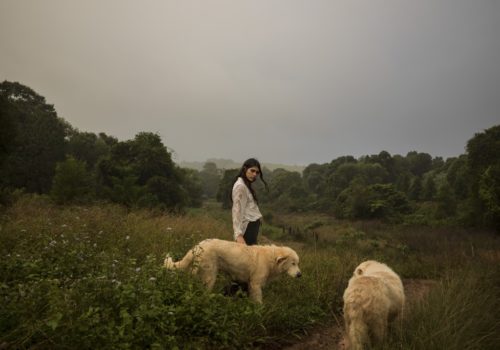In London, a selection of contemporary portraits challenges how we relate to images.
The boy looks resigned and prim, yet curious, and it is no doubt this tension and contrast between the adolescent face and the stiff uniform that is both striking and puzzling. This is a portrait of a young South-African, Thembinkosi Fanwell Ngwenya, made by Claudio Rasano, which won the 2016 Taylor Wessing Photographic Portrait Prize.
Captured against a white background, Thembinkos’s face reflects his individuality. His gaze is meaningful and defiant. At the same time, his uniform makes him less approachable to us and holds him back. Only his head looms above the imposing suit, introducing a fracture, a discontinuity with respect to the rest of his body. The thick fabric cascades downward and calls into question the capacity of the individual to extricate himself from stifling normality.
The 16th edition of the Taylor Wessing Photographic Portrait Prize highlights a diversity of techniques and formats in contemporary photography. Among the total of 4303 images by 1842 photographers, the judges have chosen 57 with the intention of showing a wide range of representations of the other. The visitor thus has the opportunity to discover a fantastic selection of portraits that challenge this “genre” in photography, the process of its production, and its interpretation.
The sublime portrait of Thea and Maxwell by the New York photographer Joni Sternbach, the winner of the second prize, is a ferrotype. The coppery, almost distressed look of this photograph transforms the couple of contemporary surfers into totemic figures and underscores our emotional and quasi-fetishistic relationship with the archive.
The portraits of the Beitar Illit family by Kovi Konowiecki, the third-prize winner, touch on the notions modernity and tradition. Photographed digitally and presented as a diptych, these sober portraits offer an enigmatic glimpse into the American Orthodox Jewish community.
An “In Focus” section complements the exhibition, featuring original work by the photographer Cristina De Middel. Gentlemen’s Club portrays male clients of prostitution in Brazil. In four portraits, the Spanish photographer delves into the dialog between the sexes and the no less complex relationship between the photographer and the photographed.
The introduction to the exhibition by Nicholas Cullinan, Director of the National Portrait Gallery, gives a sense of the scope of the project. The Taylor Wessing Photographic Portrait Prize has a global ambition: A total of 61 different nationalities have participated in the competition. Although one may question the international reach of the event—the majority of the selected photographers come from English-speaking universities and colleges—there is admittedly diversity in the choice of the individuals, locations, and themes. Again and again, the selected works also raise questions about all forms of portrait: what is individuality and how does the use of a certain visual language participate in its representation?
Julie Bonzon
Julie Bonzon is a PhD student in Art History at University College London (UCL).
16 Taylor Wessing Photographic Portrait Prize
November 17, 2016 – February 26, 2017
National Portrait Gallery
St. Martin’s Pl
London WC2H 0HE
United Kingdom
















